Issue 15, September 23, 2014
Hosta Diseases
The hosta is a popular landscaping plant, loved for its beautiful variety of foliage, and ease of cultivation. Around this time, delicate purple or white flowers develop before frost. Below are some of the most prevalent pathogens on hosta in Illinois.
Foliar nematodes
The plant clinic has received several hosta samples damaged by foliar nematodes (Aphelenchoides spp). These microscopic worms infect the above-ground parts of hostas. They are able to swim through a film of water on the leaf surface of a hosta and then enter plant tissue via natural openings or wounds. Foliar nematodes that infect hosta are able to spread to other plants in drops of splashing water or by way of gardening tools. Wet conditions throughout the summer favored their spread. Symptoms of these foliar nematodes start out as water-soaked areas within parallel veins on leaves, but later these long areas can become necrotic, dark, and maybe even tattered in appearance. To control foliar nematodes remove infected leaves, reduce overhead irrigation, and sanitize garden tools. Overwintering populations of nematode can potentially be reduced by keeping mulch and plant debris away from hosta crowns.
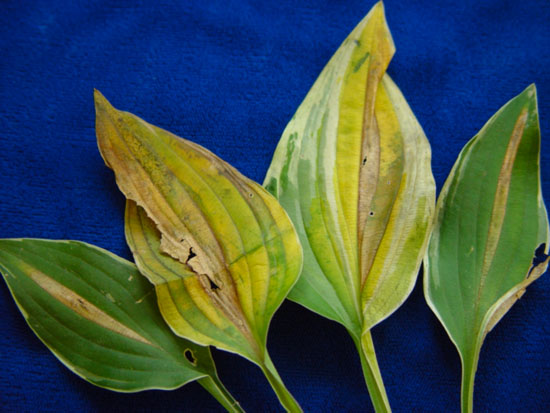
Hosta leaves infected with foliar nematodes and showing the common symptom of interveinal brown bands. Photo credit University of Illinois Plant Clinic
Petiole Blight
This is a devastating fungal disease caused by Sclerotium rolfsii. Under favorable conditions, the pathogen can rapidly take-over and defoliate an otherwise healthy hosta. It was previously named Hosta Crown Rot, but was renamed due to the fact that the pathogen attacks the petiole while the plant's crown remains unharmed.
This pathogen is particularly devastating because of its ability to survive in the soil and on the soil surface from several months to years. Survivability is attributed to the tough, mustard seed-like overwintering structures, known as sclerotia. The pathogen becomes active during warm, humid weather at which point the sclerotia germinate and tufts of white mycelium fan out over the soil surface. When the fungus comes in contact with a host, it releases oxalic acids that break-down plant cells walls and tissues. On hostas, symptoms begin as wilting and discoloration of lower leaves. In a short time the upper leaves also wilt; and close inspection shows a soft, brown rot of the base of petioles. The entire leaf soon collapses above the site of infection.
Prevention and sanitation are important for disease control. The fungus is spread by sclerotia or by mycelium growing from the sclerotia. Contaminated nursery plants and exchange between gardeners has aided long distance spread of the disease. Closely inspect plants for signs of the disease before purchasing plants or accepting plants from friends and family. If you spot the disease in your landscape, remove all of the infected plant parts, placing them directly into a bag to remove them from the garden. Be careful not to spread any of the fungal mycelium or sclerotia. Do not compost diseased plants. Remove the top several inches of soil around the plant, again being careful not to spill any as you work. Unfortunately, no effective fungicides are currently available for homeowners to use. Mulch may contribute to the overwinter survival of the pathogen. Pulling mulch back from the base of plants before winter may help to kill the fungus. There are differences in levels of susceptibility among hosta cultivars, but nothing with high levels of resistance.
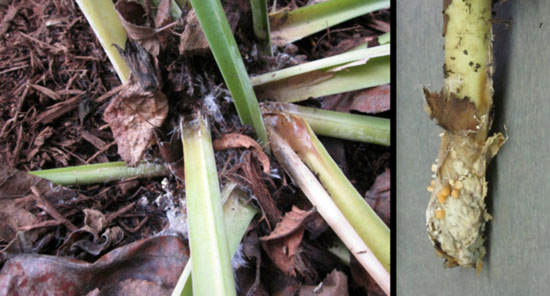
Left: Collapsed hosta petioles are covered in white mycelium of Sclerotium rolfsii at the base. Right: Base of infected hosta petiole with the small, round, tan to brown sclerotia of Sclerotium rolfsii. Photo credit Diane Plewa.
Hosta Virus X
Hosta virus X (HVX) is a pathogen that has plagued gardeners worldwide. As with most viruses, HVX will not kill hosta; however it can cause a number of undesirable symptoms such as: mosaics, yellowing, and necrosis on the foliage. Once a hosta is infected, this virus can lurk within infected plant sap, and can easily be spread by hands and garden tools. HVX can also persist in plants for years before symptoms develop, and any plants propagated from an infected plant will also develop the disease. No controls are available once the plant has been infected. Avoid introducing the disease by purchasing disease free plants from reputable sources. Destroy any symptomatic hostas, and sanitize equipment before working with nearby healthy hosta plants.
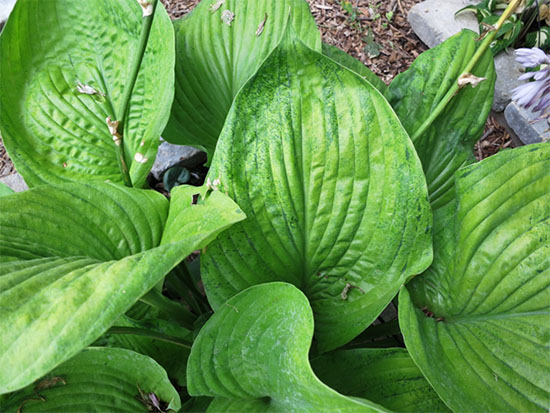
Sum and Substance hosta leaf infected with HVX and showing dark mottling symptoms. Photo credit Travis Cleveland.
Leaf Spots
Leaf spots are common to hosta. While they make plants less attractive, they rarely are considered to be serious diseases; although they can contribute to overall plant stress. There are many different fungi that cause foliar spots on hosta. Control methods for all of the hosta leaf spot diseases are similar, regardless of the fungal causal pathogen and infected area, as follows: overhead irrigation should be avoided, heavily infected leaves removed, and garden equipment sanitized. Protective fungicides can be applied before the disease infection takes place. These chemicals are especially useful for plants that were previously affected by fungal leaf spots in the past.
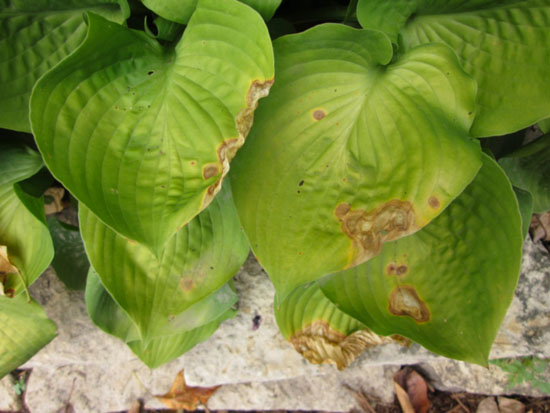
Fungal leaf spots on hosta. Photo credit Diane Plewa.
Abiotic Problems
Like all plants, hosta is susceptible to sunscald and drought stress. Slugs can also be major pests of hosta. Hosta plants prefer moist, well-drained soils. Depending on the variety, they will do well in a range of full shade to full sun (though most favor partial shade). Stressed plants tend to develop diseases more frequently than unstressed ones, so reducing stress and increasing plant vitality can be a powerful tool to prevent disease development in your garden.
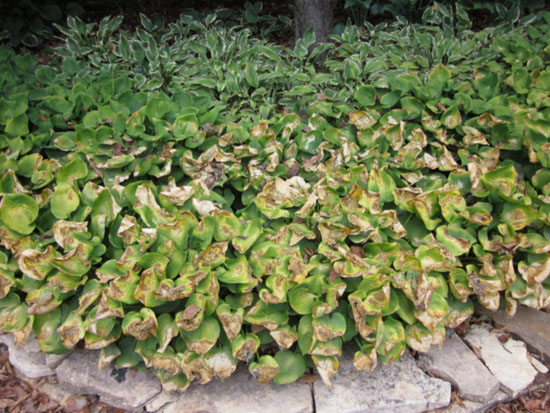
A bed of hostas stressed by sunscald and disease. Photo credit Diane Plewa.
(Diane Plewa and Travis Cleveland)
Authors:
Diane Plewa
Travis Cleveland